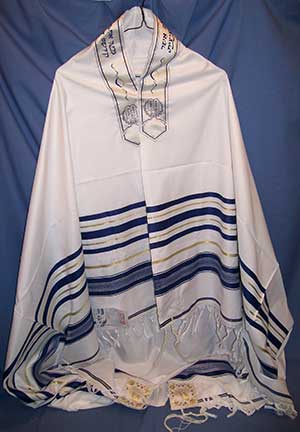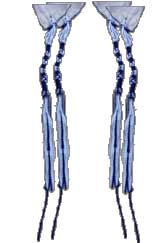 The Tallit, Jewish Prayer Shawl
The Tallit, Jewish Prayer Shawl
My wife and I have been to Israel twice, once in 1988 and once in 1998. There were souvenirs for sale everywhere, of course. We brought back some interesting things, including Dead Sea water, a widow's mite, frankincense and myrrh. Later, we wished we'd gotten some other things, like phylacteries, a shofar, and this prayer shawl, called a tallit. Susan found this one recently at a home school convention.
God himself gave the directions for the tallit in Numbers 15:
The LORD said to Moses, "Speak to the Israelites and say to them: 'Throughout the generations to come you are to make tassels on the corners of your garments, with a blue cord on each tassel. You will have these tassels to look at and so you will remember all the commands of the LORD, that you may obey them and not prostitute yourselves by going after the lusts of your own hearts and eyes. Then you will remember to obey all my commands and will be consecrated to your God. I am the LORD your God, who brought you out of Egypt to be your God. I am the LORD your God.
The most important thing about the tallit is not the size, shape, color or fabric, but the square or rectangular shape and the tassels on the four corners, which are to serve as constant reminders to praise God and obey the commandments.
 The tassels are called tzitzit. They are made of eight strands knotted and tied together in a special way. God directed the Jews to put a blue thread in each tassel. The special blue color was called tekhelet. In ancient times, blue was one of the most expensive colors to produce. Only the wealthy could afford it. The only source of blue dye was a small gland in the murex snail. It took 12,000 snails to fill a thimble with blue dye. In 200 B.C., a pound of cloth dyed blue cost the equivalent of $36,000. By 300 A.D., it cost the equivalent of $96,000. So these blue threads were very valuable and important. They represented royalty as well as the heavens and divinity. They reminded the wearer of his significance to God. Blue threads were passed from fathers to sons as precious legacies.
The tassels are called tzitzit. They are made of eight strands knotted and tied together in a special way. God directed the Jews to put a blue thread in each tassel. The special blue color was called tekhelet. In ancient times, blue was one of the most expensive colors to produce. Only the wealthy could afford it. The only source of blue dye was a small gland in the murex snail. It took 12,000 snails to fill a thimble with blue dye. In 200 B.C., a pound of cloth dyed blue cost the equivalent of $36,000. By 300 A.D., it cost the equivalent of $96,000. So these blue threads were very valuable and important. They represented royalty as well as the heavens and divinity. They reminded the wearer of his significance to God. Blue threads were passed from fathers to sons as precious legacies.
I have a thread that was actually dyed with the special dye from the murex snail. It's called a tekhelet. The method of making this dye was lost for many years but has recently been rediscovered. Some people claim that this is not exactly the same color, that the original was more purple. I've read that the color of the dye depends on whether the snails are harvested by day or by night. There's a great video online called The Mystery of the Tekhelet.
Before synthetic dyes, prayer shawls wouldn't have had blue stripes like this one does, but the symbolism is the same. The blue in the Israeli flag has the same meaning.
Only men who have completed their Bar Mitzvah may wear a tallit. It is called the "robe of responsibility" and is associated with a person's authority. In 1 Samuel 24:4, David sneaked up on Saul while he was in a cave and "cut off a corner Saul's robe." He actually cut off one of the tzitzit, a symbol of Saul's authority. This was a way of insulting or humiliating Saul. Later, David humbled himself before Saul in order to restore a peaceful relationship with him.
In Ruth 3:8-9, Ruth went to the threshing floor of Boaz at night and asked him to spread a corner of his garment over her. She was asking him to accept responsibility for her and take her under his authority and protection
The same symbolism is used for God and his beloved Israel in Ezekiel 16:8:
Later I passed by, and when I looked at you and saw that you were old enough for love, I spread the corner of my garment over you and covered your nakedness. I gave you my solemn oath and entered into a covenant with you, declares the Sovereign LORD, and you became mine.
Many people were healed when they touched the tassels of Jesus' tallit. They weren't healed just by touching his clothes, but by symbolically placing themselves under His authority and protection.
In Jesus' time, tassels had become a symbol of status. In Matthew 23:5, Jesus criticized the Pharisees by saying:
"Everything they do is done for men to see: They make their phylacteries wide and the tassels on their garments long."
The tassels of some Pharisees were so long and elaborate in Jesus' day that they dragged on the ground. Jesus saw this as a sign of pride and hypocrisy rather than holiness.
The word "corner" is knaff in Hebrew. It is sometimes translated "wings." In Jewish households on the Sabbath, the father may take his tallit and pull his children under it as he prays for them. It represents his authority over them as well as his responsibility to protect and nurture them.
Several times in the Psalms, David writes about taking refuge in the shadow of God's wings. This doesn't mean wings like a bird's. Rather, God takes us under his tallit, under his authority and protection. Think about how this meaning might apply in Malachi 4:2:
But for you who revere my name, the sun of righteousness will rise with healing in its wings.
Some say this should be Son of Righteousness (s-o-n not s-u-n). Jesus will rise with healing in His tallit and gather together those who revere Him and have placed themselves under His authority and protection. It is my hope and prayer that each of us here will be among those who welcome His coming.
Go on to read Financial Freedom
Source: www.SusanCAnthony.com, ©Susan C. Anthony
